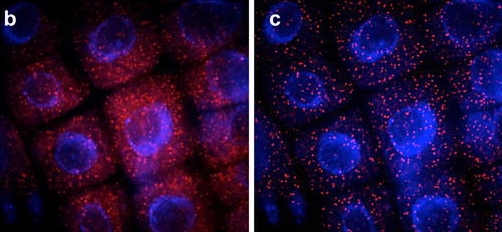Advancing the ability to image single RNA molecules at the cellular level
Susan Duncan (John Innes Centre), Susana Sauret-Guet (Department of Plant Sciences, University of Cambridge), Christian Boehm (Department of Plant Sciences, University of Cambridge)
Plant biology currently lags behind other fields in the study of cell-to-cell variation and subcellular localisation of mRNA. Dr Susan Duncan (John Innes Centre) helped to establish the first single molecule fluorescent in situ hybridisation (smFISH) method for plants, allowing each RNA molecule to be visualised as a single fluorescent dot in Arabidopsis thaliana root meristem tissue. This technique revealed subcellular localisation of coding and non-coding RNA and provided data to enable the estimation of the frequency of transcriptional firing events.
Example of smFISH in Arabidopsis. Duncan, Susan, et al. "A method for detecting single mRNA molecules in Arabidopsis thaliana." Plant methods 12.1 (2016): 13. Licensed under CC-BY 4.0
The high level of back ground autofluorescence emitted by many green plant tissues currently limits smFISH analysis to a single tissue type but with the support of the OpenPlant Fund, the team were able to optimise the existing technique and adapt it for use in other Arabidopsis tissues and to enable RNA imaging in the liverwort Marchantia polymorpha. Improvements allowed researchers to image three, rather than two, RNA targets simultaneously and led to amplified signals which were compatible with confocal imaging. RNA could also be visualized in more differentiated root cells, e.g. root hairs. OpenPlant funding also enabled Susan to collaborate on a project about boron transport and generate data for a publication (Sotta et al., 2017).
“Our work has provided a strong foundation for improved RNA imaging that will open up numerous avenues for Arabidopsis and Marchantia research in the future”
Susan was able to promote the technique at a range of conferences and through publications including a commentary piece on the technique (Duncan & Rosa, 2017). Susan was also made an expert collaborator by LGC, in recognition of her ongoing efforts to promote plant smFISH and this led to further conference presentations and planning a funded workshop.
Duncan, S., & Rosa, S. (2017). Gaining insight into plant gene transcription using smFISH. Transcription, 1-5.
Sotta, N., Duncan, S., et al. (2017). Rapid transporter regulation prevents substrate flow traffic jams in boron transport. eLife; 6:e27038. DOI: 10.7554/eLife.27038


